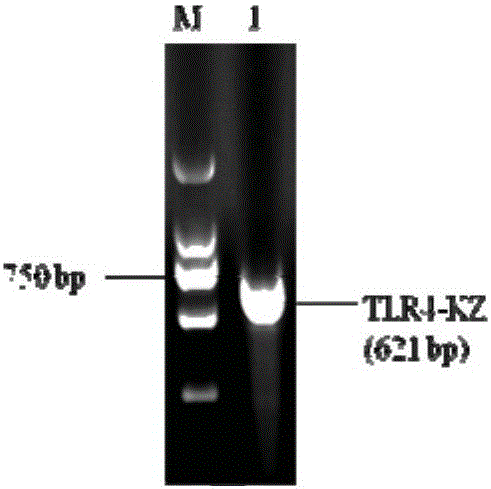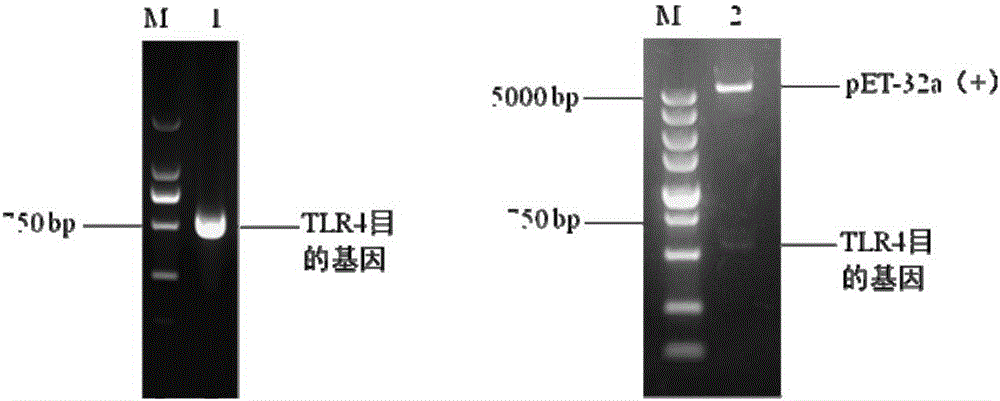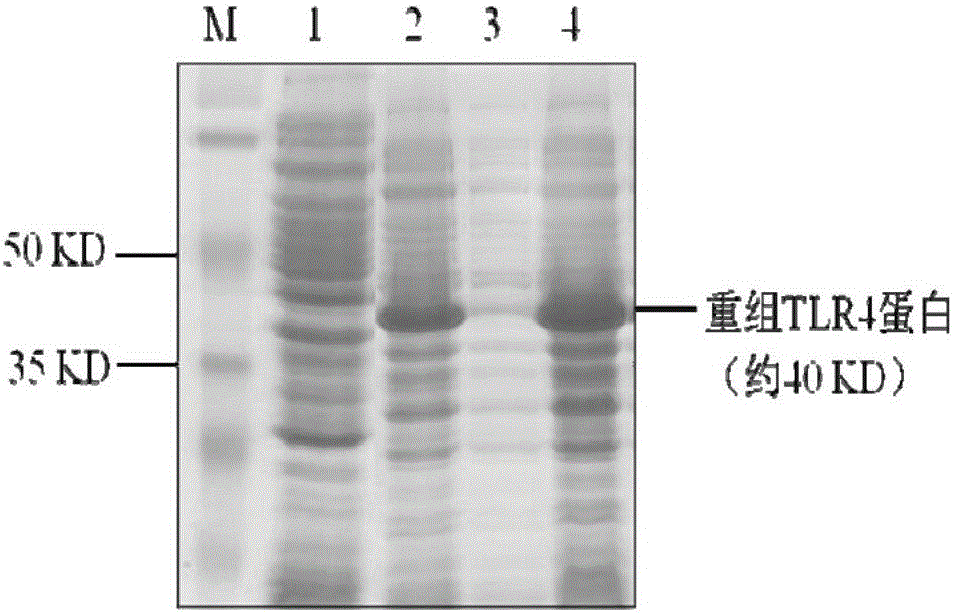Preparation method and application of porcine TLR4 polyclonal antibody
A polyclonal antibody and protein technology, applied in the direction of antibodies, anti-animal/human immunoglobulin, anti-receptor/cell surface antigen/cell surface determinant immunoglobulin, etc., can solve problems such as restricting research
- Summary
- Abstract
- Description
- Claims
- Application Information
AI Technical Summary
Problems solved by technology
Method used
Image
Examples
Embodiment 1
[0018] Example 1 Construction of TLR4 prokaryotic expression vector and genetically engineered bacteria.
[0019] According to the amino acid sequence analysis of Sus scrofa toll-like receptor 4 (TLR4) mRNA (accession number: KF460453.1) in GenBank, its hydrophobicity and linear epitope, the prokaryotic expression gene sequence was determined to be 2043-2052 with a total length of 510bp. The amino acid sequences are shown in SEQ.ID.No.3 and SEQ.ID.No.1 in the S sequence table respectively, and the clone primer F1 / R1 and the prokaryotic expression primer F2 / R2 of the target gene are designed. Collect PK-15 cells infected with swine fever virus, extract the total RNA of the cells and reverse transcription, and use primers F1 / R1 to amplify the large TLR4-KZ fragment (621bp) ( figure 1 ), and its nucleotide sequence is shown in SEQ.ID.No.2 in the Sequence Listing. Using the TLR4-KZ plasmid as a template, the prokaryotic expression sequence TLR4 (170) was obtained by PCR amplification...
Embodiment 2
[0023] Example 2 Obtaining and Purifying Recombinant TLR4 Protein
[0024] The positive genetically engineered bacteria were inoculated into sterile LB medium containing ampicillin, cultured at 37°C at 200 rpm until the optical density value (OD600) of the bacterial solution reached 0.6, IPTG was added to the final concentration of 0.05mM, and the expression was induced at 30°C for 6h, 4°C The cells were collected by centrifugation at 6000 rpm for 20 minutes, the cells were resuspended in lysis buffer, and the cells were lysed by ultrasonic wave, and the cells were centrifuged at 6000 rpm for 30 minutes at 4° C. to collect the supernatant and the precipitate. After the pellet was resuspended in PBS, and the supernatant were added 5× loading buffer and boiled for 5 minutes. SDS-PAGE was used to detect the expression level and expression form of the target protein ( image 3 ).
[0025] The recombinant protein obtained in the present invention is expressed in the form of inclusion bo...
Embodiment 3
[0026] Example 3 Preparation and Obtaining of Polyclonal Antibodies
[0027] Eight 4-week-old Kunming mice were immunized with multiple subcutaneous injections on the back on days 1, 7, 21, and 35. For the first immunization, the recombinant protein is mixed and emulsified with the same amount of Freund's complete adjuvant, and the protein immunity of each mouse is about 500 μg. Subsequent immunization was emulsified with an equal amount of Freund's incomplete adjuvant and recombinant protein, and the protein immunization amount for each mouse was about 300 μg. On the 7th day after the three immunizations, randomly select a mouse with tail-cutting and collect 100-200μL of blood into an EP tube, let it stand at room temperature for 2 hours, centrifuge at 12,000 rpm for 10 minutes at 4°C, separate the serum, and detect the prepared polyclonal by Western-blot The reactivity of antibody serum with recombinant protein confirms that mice produce specific antibodies, and the dilution o...
PUM
 Login to View More
Login to View More Abstract
Description
Claims
Application Information
 Login to View More
Login to View More - R&D
- Intellectual Property
- Life Sciences
- Materials
- Tech Scout
- Unparalleled Data Quality
- Higher Quality Content
- 60% Fewer Hallucinations
Browse by: Latest US Patents, China's latest patents, Technical Efficacy Thesaurus, Application Domain, Technology Topic, Popular Technical Reports.
© 2025 PatSnap. All rights reserved.Legal|Privacy policy|Modern Slavery Act Transparency Statement|Sitemap|About US| Contact US: help@patsnap.com



